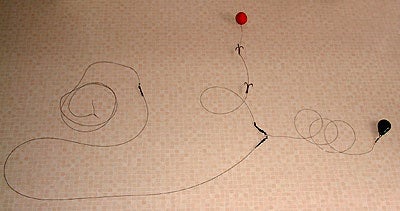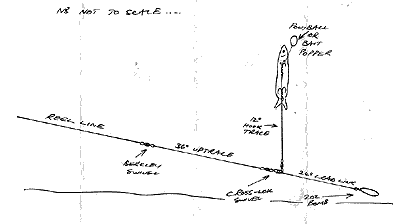THE POPPERNOSTER PIKE RIG We call this rig the poppernoster because it’s a cross between a straight leger rig and a paternoster. The beauty of it is that it gets round some of the problems you encounter when trying to pop baits up on simple leger rigs, or suspend them on sunken float paternosters. It’s quick and easy to set up. All you need is an uptrace of around 36 inches, with a strong swivel at one end (we use 60lb Berkleys) and a snap lok at the other, made of a good strong wire like 30lbs ET 49-strand; a hook trace of between 10 and 18 inches which clips to the uptrace, and a nylon link of around 24 inches, lighter than the reel line, with a 2oz bomb at the end. Wire a polyball or bait popper to the bottom treble with fuse wire and off you go. The first thing you’ll notice about the rig is it’s a lot less tangle prone. The combination of a heavy lead and buoyant bait means that if you cast it in a smooth, high arc and trap the line as it sinks, it straightens out on the way down. The lead spears straight down, the bait lags behind and even if the bait does take a turn or two around the uptrace, it should sort itself as it sinks. This is the major problem using buoyant baits on conventional leger rigs – let it sink on a slack line and the bait can tangle round the reel line. Paternoster rigs are a nightmare when you’re trying to cast a bait which is heavier than the lead, which it often is in piking. The two spin round and round as they jostle to be first and the bait often ends up tangled around the float. Once the poppernoster rig hits the bottom, just wind down until you’re tight to the bomb and clip on a drop-off indicator. Another advantage of the rig is the buoyancy of the bait helps keep the line tight and the indicator tensioned correctly, because it tries to rise up. With the rig set ‘tight’, you’re fishing a bait a little more than the length of the hook trace above the bottom. The beauty is it stays up even if the bomb sinks into silt or weed, and it can’t ‘droop’ and let the bait down into the weed like a sunken float rig can under the weight of the line. Pull off a foot of line and the bait will rise a little higher, or you can of course experiment with different lengths of hook trace – just make sure the uptrace is at least a foot or 18 inches longer, so a fish which comes towards you can’t get the reel line in its mouth. I find I can cast up to a four or five foot uptrace and two foot lead link at a push with a 12ft rod, so I can pop a bait up a couple of feet above the deck in heavy pondweed. Another thing you can do is jiggle the bait up and down a few inches, or twitch it back towards you. Takes either show as straightforward pulls if the fish picks the bait up and moves away, or a drop back if it moves to the side or towards you. As soon as this happens wind down and strike – for obvious reasons. If the bomb snags the link should break before the reel line – I usually use 30lb Fireline on the reel and an 8lbs or 10lbs bs lead link. The rig works well on drains and rivers and for medium-range fishing on gravel pits and stillwaters. It’s great for casting down the margins and twitching back towards you. An inch polyball will easily hold up an eight-inch herring, sardine or joey mackerel. Pick them up for a few pence in your local craft shop, or even try a wine cork. The beauty of it is as long as you let it sink on a tight line and have a fairly heavy lead/bouyant bait, it straightens out on the way down – so if the bait takes a couple of turns around the up-trace, it untangles as it sinks. | ||
|
Welcome!Log into your account












